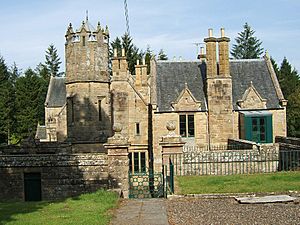George Cranstoun, Lord Corehouse facts for kids
George Cranstoun, Lord Corehouse (born 1770 – died 1850) was an important Scottish figure. He was a lawyer, a judge, and a writer known for his funny, critical stories (a satirist). He played a big role in Scottish law during his time.
Contents
The Life of George Cranstoun
Early Life and Legal Career
George Cranstoun was probably born at his family's home, Longwarton, in Scotland. He was the second son of George Cranstoun and Maria Brisbane. His family had connections to important Scottish lords.
Even though he was first meant to join the army, George chose a different path. He became a lawyer, joining the Faculty of Advocates in 1793. This was a group of top lawyers in Scotland. He then became a "depute-advocate" in 1805. This meant he helped the main legal officer. In 1806, he became a "sheriff-depute" for Sutherland, which was like being a local judge.
Becoming a Judge
George Cranstoun was highly respected by his fellow lawyers. In 1823, they chose him to be the "dean" of the Faculty of Advocates. This was a very important leadership role.
Just three years later, in 1826, he was made a judge. He took the title of Lord Corehouse. This name came from his home, Corehouse, which was near the beautiful Corra Linn waterfall on the River Clyde.
In the early 1830s, Lord Corehouse lived in a very stylish house. It was at 12 Ainslie Place in Edinburgh. This area was known for its fancy homes.
Later Years and Retirement
In January 1839, Lord Corehouse faced a sudden health challenge. He had a stroke, which made him unable to continue his work. This meant he had to retire from being a judge. He passed away on June 26, 1850.
Friends and Writings
Important Friendships
George Cranstoun was very good at studying ancient Greek. This skill helped him become friends with Lord Monboddo, another famous Scottish thinker.
While studying law in 1788, George met the famous writer Walter Scott. They became lifelong friends. Walter Scott even read parts of his famous poem, Lay of the Last Minstrel, to George Cranstoun and another friend.
His Satirical Work
While working as a lawyer, George Cranstoun also enjoyed writing. He wrote a funny, critical story called 'The Diamond Beetle Case.' In this story, he made fun of how some judges spoke and gave their opinions. He was known for his clever sense of humor.
Family Connections
George Cranstoun had two notable sisters. His second sister, Jane Anne, later became Countess of Purgstall. She was also a friend and wrote letters to Walter Scott. His youngest sister, Helen D'Arcy Stewart, was a well-known poet. She was also a popular host for social gatherings in Edinburgh. Helen was married to the famous philosopher Dugald Stewart.




